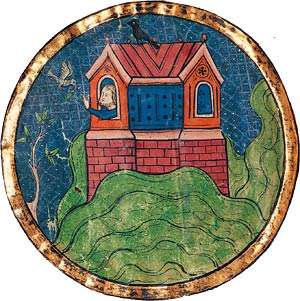Mountains of Ararat
_mountain_view.jpg)

The Mountains of Ararat (Armenian: Արարատ, Biblical Hebrew הָרֵי אֲרָרָט, Tiberian hārēy Ǎrārāṭ, Septuagint: τὰ ὄρη τὰ Ἀραράτ) is the place named in the Book of Genesis where Noah's Ark came to rest after the great flood (Genesis 8:4).
History
In the Armenian tradition and Western Christianity, based on Jerome's reading of Josephus, the specific summit of the "Mountains of Ararat" where Noah's ark landed is identified as Mount Masis (now known as Mount Ararat) the highest peak of the Armenian Highland, located in present-day Turkey. In Syrian tradition, as well as in Quranic tradition, the mountain is identified with Mount Judi in what is today Şırnak Province, Southeastern Anatolia Region, Turkey. During the Middle Ages, this tradition has eclipsed the earlier association with Mount Judi in Eastern Christianity (Syrian Christianity), and the Mount Judi tradition is now mostly confined to the Islamic view of Noah.
The "Mountains of Ararat" in Genesis clearly refer to a general region, not a specific mountain. Biblical Ararat corresponds to Ancient Assyrian Urartu (and Old Persian Armina) the name of the kingdom which at the time controlled the Lake Van region.
The Latin Vulgate says "requievitque arca [...] super montes Armeniae", which means literally "and the ark rested [...] on the mountains of Armenia", which was changed to "... mountains of Ararat" (montes Ararat) in the modern Nova Vulgata.
The Book of Jubilees (7:1) specifies that the Ark came to rest on one of the peaks of the "Mountains of Ararat" called "Lubar".
In the book, Antiquities of the Jews, Josephus wrote:
| “ | the ark rested on the top of a certain mountain in Armenia ... However, the Armenians call this place, αποβατηριον 'The Place of Descent'; for the ark being saved in that place, its remains are shown there by the inhabitants to this day. Now all the writers of barbarian histories make mention of this flood, and of this ark; among whom is Berossus. For when he is describing the circumstances of the flood, he goes on thus: "It is said there is still some part of this ship in Armenia, at the mountain of the Cordyaeans; and that some people carry off pieces of the bitumen, which they take away, and use chiefly as amulets for the averting of mischiefs." Hieronymus the Egyptian also, who wrote the Phoenician Antiquities, and Mnaseas, and a great many more, make mention of the same. Nay, Nicolaus of Damascus, in his ninety-sixth book, hath a particular relation about them; where he speaks thus: "There is a great mountain in Armenia, over Minyas, called Baris, upon which it is reported that many who fled at the time of the Deluge were saved; and that one who was carried in an ark came on shore upon the top of it; and that the remains of the timber were a great while preserved. This might be the man about whom Moses the legislator of the Jews wrote." (I.3.5-6, trans. William Whiston) | ” |
Sir Walter Raleigh devoted several lengthy chapters of his History of the World (written c. 1616) to his argument that the "Mountains of Ararat" were anciently understood as including not only those of Armenia, but all the taller mountain ranges extending into Asia far to the east, and that Noah's Ark must have landed somewhere in the Orient, since Armenia is not actually east of Shinar.
See also
References
- Friedrich Murat, Ararat und Masis, Studien zur armenischen Altertumskunde und Litteratur, Heidelberg, 1900.